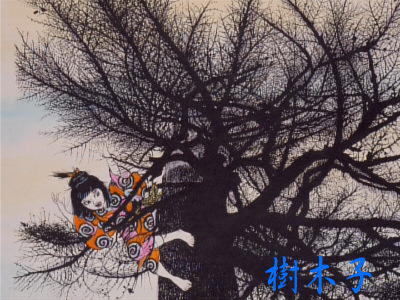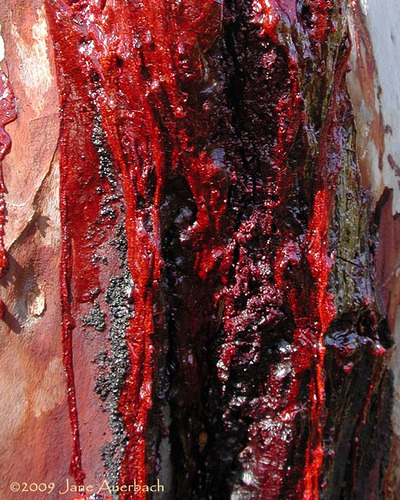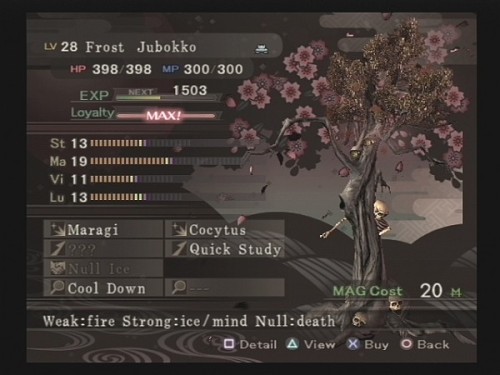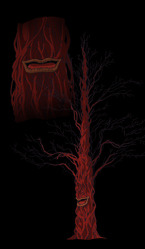Really. You'll recall last year at this time, the week leading up to Halloween, I posted an entry a day detailing Japanese ghost stories and folk tales. Well, I'm ready to do it again! But instead of ghost stories, this year I'd like to tell you about seven yōkai.
Now, you may recall that yōkai aren't necessarily a "scary" thing in Japan. Of course, I think some of the yōkai I will cover this week will be quite scary, but some yōkai are just troublemakers, and some are even helpful. But we won't talk about those since it's near Halloween. I'll stick to ones that are generally frightening or, barring that, at least manage to cause death and destruction. Even though the word "yōkai" is often translated into English as "monster," in Japan they run the gamut from the horrifically demonic, to helpful house-keepers. Mostly they leave humans alone and want to be left alone, and only strike out with anger if they are disturbed, or wronged, or bored. Mostly, yōkai are just creatures, things, unique to Japan, part of the odd and wonderful nature of things that dwell within our country. We fear them, we respect them, we put up with them. Many yōkai scholars describe yōkai as the embodiment of strange or unexplainable phenomena. "What is that strange sound outside of my house?" "Oh, it must be one of those types of yōkai that makes sounds like that." "Why do I have an ache in my ear?" "Oh, it must be one of these yōkai that like to mess with humans' ears." Many such yōkai came about this way. But then, what about the particularly well-known and disturbing ones whose stories seem to have spread throughout the country on their own? Thousands of people across Japan don't just happen to come up with the same stories and ideas about the appearance and habits of yōkai simultaneously.
Well, it's because they're real, of course.
It's true, they're not seen so often as they were back in the days of Old Edo, but it's not because of new scientific understanding or loss of interest. Yōkai are still everywhere in Japan, people just forget how to see them, because they don't know what they're looking for. But yōkai should never be forgotten. They are essential in the preservation of Japanese folk culture, and an important and fascinating element of the country.
So, let's do a series of yōkai corresponding to the elements!
I have to have a theme, right? There are far, far too many yōkai to just choose at random. So let's start out in order of the gogyou (五行), the five elements in accordance with Chinese philosophy. First up is wood, 木.
You may recall last year that I did a semi-yōkai legend, that of the Jinmenju. But you can't believe that Japan is the type of country to have just one frightening monster tree. In fact, we have several. Today, let's learn about the Jubokko,(樹木子).
If you've ever seen a samurai movie, you know that Japan has a long and bloody history of war and executions. In some of your campier films, you'll see more blood thrown around than clever wordplay, and Japan is a country that loves its wordplay. Dying a particularly violent or unjust death makes weird, bad things happen, as the numerous vengeful onryō ghosts and yōkai roaming around have shown us. But what about all of that spilled blood? It has to go somewhere, too.
Battle and execution sites are wrought with misfortune, and the large amounts of angry blood seeping into the ground causes a particularly vicious breed of yōkai.
Trees on these sites, roots innocently searching for nutrients, were fed large amounts of blood, and it spread up through the tree like it was running through human veins. As the blood gave so much more nourishment than mere water, the Jubokko trees found themselves addicted to it. Soon, the trees had turned themselves into vampiric demons, only able to feed off of human blood.
Of course, eventually the wars ended and execution sites were closed down or moved. However, the vampiric trees remained. Standing in the now-empty fields, they shift their leaves and branches, not toward the sun, but toward the pathways. When humans walk by, the branches lash out and envelop the person, striking at him and sucking his blood into their abnormal veins. It is said that the Jubokko prefer to feed from children, as a child's blood keeps the tree looking unnaturally fresh and healthy.

Naturally, the death of their children and loved ones by vampire tree was something the people of Japan wished to prevent. Taking axes to the Jubokko, they found the trees much stronger than normal trees, and when cut open, would bleed just as a human would.

It is unknown how to tell if a tree is a Jubokko other than cutting into it or staying wary of particularly fresh-looking trees standing ominously in weird old battlegrounds. Some stories say they're also able to communicate with one another into shifting position and disorienting the traveller so that he becomes lost and encircled by the Jubokko horde, which then feeds on his blood. I guess the best advice I can give to you is... well... if you're wandering around in Japan, don't stand too close to the trees.

Jubokko as they appear in Devil Summoner.
But don't be too afraid! You should always try to enjoy nature in Japan. Recently, a group of yōkai experts held an academic conference and thoroughly discussed the history of the Jubokko. The group decided that they were unable to find any hard evidence detailing the origins or sightings of the Jubokko prior to its appearance in the Yōkai Encyclopædia of yōkai master Mizuki Shigeru, determined that it must have been invented by him, though Mizuki never reveals which yōkai are real and which are the product of his own imagination.

A Jubokko in Mizuki's famous work, GeGeGe no Kitarō.
I wish I could have been at that yōkai conference.
No comments:
Post a Comment